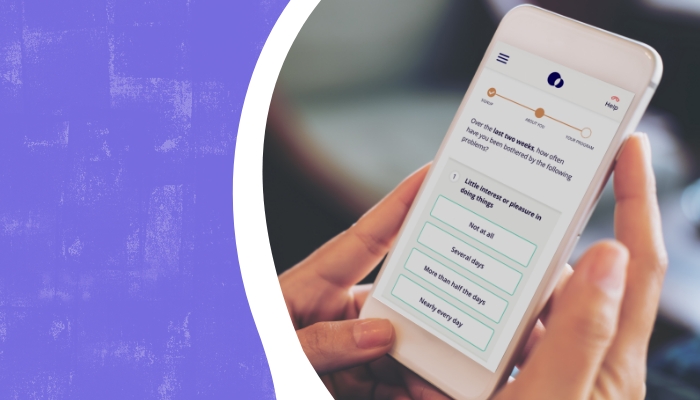 What do we mean by engagement?
What do we mean by engagement?
Engagement has been conceptualised differently across fields of study; for example, in the computer science and human-computer interaction fields, engagement has been described as the experience of flow or as someone’s subjective experience, whereas in the behavioral science field, engagement has been predominantly described in terms of usage of the digital behavioral change interventions1. For example, engagement has been described as the “dose” participants receive or as the “adherence” to the intervention1.
Overall, patient engagement with digital interventions encompasses their active participation in the treatment content and it is one of the buzzwords commonly used in digital mental health. However, as addressed in one of our recent podcasts, ‘Adherence and engagement with digital interventions’ there is a difference between adhering and engaging with an intervention, with the former referring to a patient following a treatment plan while the latter implies more actions from the user (e.g., reading materials). The podcast, and one of our blogs, 'Low-engagement in online psychological treatments' addressed the relationship between usage and outcomes and whether there’s an optimal dose of engagement.
While there’s some indication that the degree of use of an intervention is associated with outcomes, most of the work so far has relied on the assumption that “the more usage, the better” without finding usage thresholds that lead to clinical improvement. Moreover, usage metrics do not account for the depth of involvement with the platform. Some studies suggest there is a difference between active and passive engagement with a platform, where the first one refers to users that actively engage with the intervention (e.g. completing activities, posting, commenting), while the latter refers to users reading content without necessarily performing any actions or applying the material learned2,1,3.
A recent review found that across different domains, engagement contains emotional, behavioral, and cognitive components4 and it has been suggested that researchers should aim to address both the objective aspects of engagement (e.g., system usage metrics) and the subjective aspects such as the experience of the users5,6 when evaluating engagement in mHealth interventions. Moreover, understanding the extent to which patient engagement strategies translate into improvements in engagement could inform the development and dissemination of more efficacious standalone digital interventions.
Why is it important for patients to engage?
Despite the positive outcomes associated with digital mental health interventions across different populations, symptoms, and countries, there still remains a large proportion of patients not completing the full course of their treatment (for a more detailed account of this important issue see our previous blog posts, 'Low-engagement in online psychological treatments') and the lack of engagement has been reported as a barrier in the dissemination of mental health treatments.
Moreover, while supported interventions seem to lead to better patient outcomes, standalone mental health digital interventions require fewer resources than those that are supported so there’s a need to understand how to increase engagement without therapist involvement. This may require adopting conditions similar to the valuable behaviors provided in supported treatments such as sending reminders or providing positive feedback. Not least, there’s some evidence that apps employing more patient engagement strategies/features lead to better clinical outcomes7. This shows the importance of engagement techniques to improve the efficacy of digital mental health interventions.
What are patient engagement strategies?
Rooted in human-computer interaction, computer-mediated communication, and persuasive technology, Persuasive system design (PSD) is a framework that categorises an app’s features into four mechanisms to increase user engagement: facilitating the primary purpose of the app, promoting user-app interactions, leveraging social relationships, and increasing app credibility.
Features that increase engagement through primary task support include;
- Reduction - i.e., breaking down a target behavior into smaller steps
- Tailoring - i.e., adapting the information presented by the system to the user’s needs, interests, usage context etc.
- Personalisation - i.e., offering personalized content such as mentioning the user’s name
- Self-monitoring - i.e., the ability to track one’s progress.
Other patient engagement strategies could use app features that offer; praise, rewards, reminders, or suggestions, which increase engagement by providing dialogue support. Social support is another mechanism for increasing engagement through social learning, cooperation, competition etc. Not lastly, credibility support can lead to more engaged users if the app incorporates expertise, a real-world feel, third-party endorsements, and other similar features7.
From a different angle, Behavioral Economics (BE) aims to understand how decision-making differs from expected “rational” models. Common findings from BE are that people are motivated by avoiding losses, “starting fresh”, committing to action, and by lotteries7. Moreover, gamification features such as avatars, badges, points, and levels often overlap with PSD and BE techniques and overall may serve to increase engagement7.
Which patient engagement strategies are commonly used?
A review8 in the area of digital mental health interventions identified three main categories of factors that contribute to patient engagement: user characteristics (e.g., severe mental health problems can become a barrier), user experience (e.g., users are more likely to engage with an intervention if they perceive it as a good fit), and the technology and implementation environment (e.g., technical issues can be barriers). Other studies9,10 have found that incorporating persuasive design and PSD features can increase adherence to digital mental health interventions, suggesting that designing more engaging interventions could lead to higher numbers of patients completing an intervention, and therefore benefitting from it.
A recent meta-analysis7 of smartphone apps designed to treat depression and/or anxiety went even further and examined which features increase engagement with the apps. They found that across 25 studies involving 4159 participants and using 29 different apps, some PSD features (e.g. reduction, self-monitoring, personalisation from the primary task support category) were incorporated in almost all apps, while other PSD features (e.g. cooperation, competition, recognition, third-part endorsements from the dialogue and credibility support categories) and BE features were rarely incorporated. This could be due to PSD being a well-established method of developing new interventions, while BE has not been applied to the field of mental health interventions until fairly recently.
Recommendations for increasing engagement
Overall, incorporating more patient engagement strategies in the design of an intervention is likely to lead to better adherence and increased efficacy. Designers may need to draw from a range of theoretical frameworks and engagement features to maximize the impact of their interventions, starting with PSD features. This includes delivering content gradually, so the tasks are broken into smaller steps, providing tailored feedback, allowing for user personalisation, and offering reminders as well as praise and rewards. Leveraging social support in particular, which is currently under-used, may be beneficial since this category bridges both PSD and BE, and may be a promising avenue for exploration as it could engage the users in the absence of a therapist or coach, and is a predictor of mental health outcomes itself (for more information on social support, see one of our previous blogs, 'July is Social Wellness Month')
Recently, SilverCloud’s own Space from Depression has undergone attempts to improve patient engagement through a smartwatch app integration (for more information see our recent blog post, ‘How Smartwatches Can Promote User Engagement and Self-monitoring with Digital Mental Health Programmes’.) Wearable technologies, such as wrist-worn smartwatches, facilitate the immediate and automatic collection of health data and provide further opportunities to incorporate patient engagement solutions.
References
1. Perski, O., Blandford, A., West, R., & Michie, S. (2017). Conceptualising engagement with digital behaviour change interventions: a systematic review using principles from critical interpretive synthesis. Translational behavioral medicine, 7(2), 254-267.
2. Bendelin, N., Hesser, H., Dahl, J., Carlbring, P., Nelson, K. Z., & Andersson, G. (2011). Experiences of guided Internet-based cognitive-behavioural treatment for depression: a qualitative study. BMC psychiatry, 11(1), 1-10.
3. Beintner, I., Vollert, B., Zarski, A. C., Bolinski, F., Musiat, P., Görlich, D., ... & Jacobi, C. (2019). Adherence reporting in randomized controlled trials examining manualized multisession online interventions: systematic review of practices and proposal for reporting standards. Journal of medical Internet research, 21(8), e14181.
4. Kelders, S. M., Van Zyl, L. E., & Ludden, G. D. (2020). The concept and components of engagement in different domains applied to ehealth: a systematic scoping review. Frontiers in psychology, 11, 926.
5. Bruce, C., Harrison, P., Giammattei, C., Desai, S. N., Sol, J. R., Jones, S., & Schwartz, R. (2020). Evaluating Patient-Centered Mobile Health Technologies: Definitions, Methodologies, and Outcomes. JMIR mHealth and uHealth, 8(11), e17577.
6. Short, C. E., DeSmet, A., Woods, C., Williams, S. L., Maher, C., Middelweerd, A., ... & Crutzen, R. (2018). Measuring engagement in eHealth and mHealth behavior change interventions: viewpoint of methodologies. Journal of medical Internet research, 20(11), e9397.
7. Wu, A., Scult, M. A., Barnes, E. D., Betancourt, J. A., Falk, A., & Gunning, F. M. (2021). Smartphone apps for depression and anxiety: a systematic review and meta-analysis of techniques to increase engagement. NPJ digital medicine, 4(1), 1-9.
8. Borghouts, J., Eikey, E., Mark, G., De Leon, C., Schueller, S. M., Schneider, M., ... & Sorkin, D. H. (2021). Barriers to and facilitators of user engagement with digital mental health interventions: systematic review. Journal of medical Internet research, 23(3), e24387.
9. Baumel, A., & Yom-Tov, E. (2018). Predicting user adherence to behavioral eHealth interventions in the real world: examining which aspects of intervention design matter most. Translational behavioral medicine, 8(5), 793-798.
10. Kelders, S. M., Kok, R. N., Ossebaard, H. C., & Van Gemert-Pijnen, J. E. (2012). Persuasive system design does matter: a systematic review of adherence to web-based interventions. Journal of medical Internet research, 14(6), e152.







